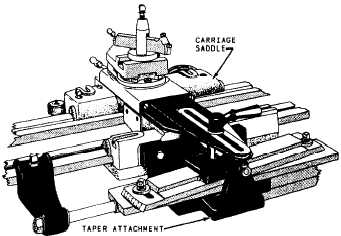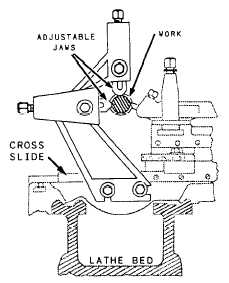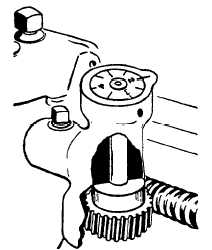Figure 9-14.—Follower rest.
Figure 9-15.—Taper attachment.
2. To support and provide a center bearing for one
end of the work, such as a shaft, being bored or drilled
from the end when it is too long to be supported by a
chuck alone. The center rest is clamped in the desired
position on the bed and is kept aligned by the ways, as
illustrated in figure 9-13. The jaws (A) must be carefully
adjusted to allow the work (B) to turn freely and at the
same time remain accurately centered on the axis of the
lathe. The top half of the frame is a hinged section (C)
for easier positioning without having to remove the
work from the centers or to change the position of the
jaws.
Follower Rest
The follower rest is used to back up small diameter
work to keep it from springing under the cutting
Figure 9-16.—Thread dial Indicator.
pressure. It can be set to either precede or follow the
cutting action. As shown in figure 9-14, it is attached
directly to the saddle by bolts (B). The adjustable jaws
bear directly on the part of the work opposite the cutting
tool.
Taper Attachment
The taper attachment, illustrated in figure 9-15, is
used for turning and boring tapers. It is bolted to the back
of the carriage. In operation, it is connected to the cross
slide so that it moves the cross slide traversely as the
carriage moves longitudinally, thereby causing the
cutting tool to move at an angle to the axis of the work
to produce a taper.
The desired angle of taper is set on the guide bar of
the attachment. The guide bar support is clamped to the
lathe bed Since the cross slide is connected to a shoe
that slides on this guide bar, the tool follows along a line
parallel to the guide bar and at an angle to the work axis
corresponding to the desired taper.
The operation of the taper attachment will be further
explained under the subject of taper work
Thread Dial Indicator
The thread dial indicator, shown in figure 9-16,
eliminates the need to reverse the lathe to return the
carriage to the starting point each time a successive
threading cut is taken. The dial, which is geared to the
lead screw, indicates when to clamp the half-nuts on the
lead screw for the next cut.
The threading dial consists of a worm wheel which
is attached to the lower end of a shaft and meshed with
9-9






